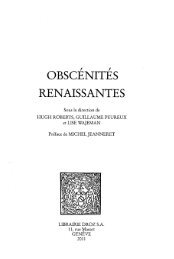Download (3398Kb) - ePrints Soton - University of Southampton
Download (3398Kb) - ePrints Soton - University of Southampton
Download (3398Kb) - ePrints Soton - University of Southampton
You also want an ePaper? Increase the reach of your titles
YUMPU automatically turns print PDFs into web optimized ePapers that Google loves.
X D a ta<br />
survival respectively. Survival remained high (more than 90 %) at all pressures at 10<br />
and 15°C (Fig. 3.17).<br />
percentage<br />
100<br />
80<br />
60<br />
40<br />
20<br />
0<br />
100<br />
80<br />
60<br />
40<br />
20<br />
0<br />
100<br />
80<br />
60<br />
40<br />
20<br />
0<br />
100<br />
80<br />
60<br />
40<br />
20<br />
0<br />
100<br />
80<br />
60<br />
40<br />
20<br />
0<br />
5 o C<br />
U 2 48 32<br />
B ELA<br />
10 o C<br />
15 o C<br />
20 o C<br />
U 2 48 32 B ELA U 2 48 32 B ELA U 2 48 32 B ELA<br />
200 atm 150 atm 100 atm 50 atm 1 atm<br />
D evelopm ental Stage<br />
Fig. 3.15. Marthasterias glacialis embryos incubated at 5, 10, 15 and 20° C at 1, 50,<br />
100, 150 and 200 atm for 48 h. Histogram represent % mean and SD. Development<br />
stages are (U) Uncleaved, 2 to 32 cell, (B) Blastula, (E) Early gastrula, (L) Late<br />
gastrula and (A) Abnormal.<br />
3.4- Discussion<br />
Experimental work on the pressure and temperature tolerances <strong>of</strong> embryos and<br />
larvae <strong>of</strong> shallow water echinoids suggest that they are capable <strong>of</strong> entering the deep<br />
sea along isotherms, but across isobars. In the northern Mediterranean (Young et al.,<br />
1997) embryos and larvae <strong>of</strong> the shallow water echinoids Paracentrotus lividus<br />
(Lamarck), Arbacia lixula, and Sphaerechinus granularis tolerated pressures as high<br />
as 150 atm at 15° C. Lower temperatures (
















